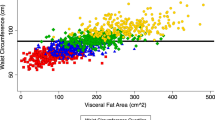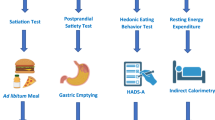Abstract
Background
Interventions such as testosterone treatment may change body composition and metabolic outcomes without substantial changes in weight and BMI.
Objectives
Using testosterone treatment as a paradigm, we hypothesized that a body shape index (ABSI) reflects body composition changes more accurately than traditional markers, such as weight, BMI and waist circumference.
Intervention
Secondary analysis of a 56-week RCT in 100 dieting obese men with low–normal testosterone receiving testosterone treatment or placebo, and subsequent off-treatment follow-up.
Results
At the end of the trial period, ABSI—unlike weight, BMI or waist circumference—had significantly decreased in the treatment group, compared with placebo (mean adjusted difference −0.18 [95% CI: −0.32, −0.05] × 10−2 m11/6kg−2/3, overall P<0.001). Changes in ABSI during the active trial phase correlated with changes in fat mass (tau = 0.18, P = 0.02), and not with lean mass (tau = −0.11, P = 0.14), BMI (tau = 0.10, P = 0.17), or visceral fat (tau = 0.07, P = 0.37). ABSI baseline values were positively correlated with waist circumference (tau = 0.21, P = 0.002) and visceral fat (tau = 0.18, P = 0.009), correlated inversely with lean mass (tau = −0.21, P = 0.002), and were uncorrelated with BMI (tau = −0.10, P = 0.15) and fat mass (tau = 0.01, P = 0.83). Two years after cessation of treatment, ABSI again reflected body composition as the between-group differences in all parameters did not persist.
Conclusions
A readily obtainable anthropomorphic measure, ABSI reflects the differential loss of fat mass mediated by testosterone in dieting obese men more closely than BMI or waist circumference. It may serve as a clinically useful marker to monitor body composition changes, particularly in response to interventions.
This is a preview of subscription content, access via your institution
Access options
Subscribe to this journal
Receive 12 print issues and online access
$259.00 per year
only $21.58 per issue
Buy this article
- Purchase on Springer Link
- Instant access to full article PDF
Prices may be subject to local taxes which are calculated during checkout

Similar content being viewed by others
References
Wu FCW, Tajar A, Pye SR, Silman AJ, Finn JD, O’Neill TW, et al. Hypothalamic-pituitary-testicular axis disruptions in older men are differentially linked to age and modifiable risk factors: the European male aging study. J Clin Endocrinol Metab. 2008;93:2737–45.
Grossmann M. Hypogonadism and male obesity: focus on unresolved questions. Clin Endocrinol (Oxf). 2018;89:11–21.
Bhasin S. The brave new world of function-promoting anabolic therapies: testosterone and frailty. J Clin Endocrinol Metab. 2010;95:509–11.
Corona G, Giagulli VA, Maseroli E, Vignozzi L, Aversa A, Zitzmann M, et al. Testosterone supplementation and body composition: Results from a meta-analysis of observational studies. J Endocrinol Invest. 2016;39:967–81.
Storer TW, Basaria S, Traustadottir T, Harman SM, Pencina K, Li Z, et al. Effects of testosterone supplementation for 3 years on muscle performance and physical function in older men. J Clin Endocrinol Metab. 2017;102:583–93.
Traish AM, Haider A, Haider KS, Doros G, Saad F. Long-term testosterone therapy improves cardiometabolic function and reduces risk of cardiovascular disease in men with hypogonadism: A real-life observational registry study setting comparing treated and untreated (control) groups. J Cardiovasc Pharmacol Ther. 2017;22:414–33.
Haider KS, Haider A, Doros G, Traish A. Long-term testosterone therapy improves urinary and sexual function, and quality of life in men with hypogonadism: results from a propensity matched subgroup of a controlled registry study. J Urol. 2018;199:257–65.
Ng Tang Fui M, Prendergast LA, Dupuis P, Raval M, Strauss BJ, Zajac JD, et al. Effects of testosterone treatment on body fat and lean mass in obese men on a hypocaloric diet: a randomised controlled trial. BMC Med. 2016;14:153.
Romero-Corral A, Lopez-Jimenez F, Sierra-Johnson J, Somers VK. Differentiating between body fat and lean mass-how should we measure obesity. Nat Clin Pract Endocrinol Metab. 2008;4:322–3.
Okorodudu DO, Jumean MF, Montori VM, Romero-Corral A, Somers VK, Erwin PJ, et al. Diagnostic performance of body mass index to identify obesity as defined by body adiposity: a systematic review and meta-analysis. Int J Obes (Lond). 2010;34:791–9.
Segal KR, Dunaif A, Gutin B, Albu J, Nyman A, Pi-Sunyer FX. Body composition, not body weight, is related to cardiovascular disease risk factors and sex hormone levels in men. J Clin Invest. 1987;80:1050–5.
Bigaard J, Frederiksen K, Tjønneland A, Thomsen BL, Overvad K, Heitmann BL, et al. Body fat and fat-free mass and all-cause mortality. Obes Res. 2004;12:1042–9.
Gómez-Ambrosi J, Silva C, Galofré JC, Escalada J, Santos S, Millán D, et al. Body mass index classification misses subjects with increased cardiometabolic risk factors related to elevated adiposity. Int J Obes (Lond). 2012;36:286–94.
Nevill AM, Stewart AD, Olds T, Holder R. Relationship between adiposity and body size reveals limitations of BMI. Am J Phys Anthropol. 2006;129:151–6.
Balkau B, Deanfield JE, Després JP, Bassand JP, Fox KA, Smith SC, et al. International day for the evaluation of abdominal obesity (IDEA): a study of waist circumference, cardiovascular disease, and diabetes mellitus in 168,000 primary care patients in 63 countries. Circulation. 2007;116:1942–51.
Moore SC. Waist versus weight: which matters more for mortality. Am J Clin Nutr. 2009;89:1003–4.
World Health Organisation. Waist Circumference and Waist-Hip Ratio: Report of a WHO Expert Consultation, Geneva, 8–11 December 2008. Technical Report, World Health Organization, 2011.
Krakauer NY, Krakauer JC. A new body shape index predicts mortality hazard independently of body mass index. PLoS One. 2012;7:e39504.
Krakauer NY, Krakauer JC. Untangling waist circumference and hip circumference from body mass index with a body shape index, hip index, and anthropometric risk indicator. Metab Syndr Relat Disord. 2018;16:160–5.
Krakauer NY, Krakauer JC. Dynamic association of mortality hazard with body shape. PLoS ONE. 2014;9:e88793.
Ji M, Zhang S, An R. Effectiveness of a body shape index (ABSI) in predicting chronic diseases and mortality: a systematic review and meta-analysis. Obes Rev. 2018;19:737–59.
Harwood DT, Handelsman DJ. Development and validation of a sensitive liquid chromatography-tandem mass spectrometry assay to simultaneously measure androgens and estrogens in serum without derivatization. Clin Chim Acta. 2009;409:78–84.
Ng Tang Fui M, Hoermann R, Zajac JD, Grossmann M. The effects of testosterone on body composition in obese men are not sustained after cessation of testosterone treatment. Clin Endocrinol (Oxf). 2017;87:336–43.
Mason C, Katzmarzyk PT. Variability in waist circumference measurements according to anatomic measurement site. Obesity . 2009;17:1789–95.
Kapoor D, Clarke S, Stanworth R, Channer KS, Jones TH. The effect of testosterone replacement therapy on adipocytokines and C-reactive protein in hypogonadal men with type 2 diabetes. Eur J Endocrinol. 2007;156:595–602.
Heymsfield SB, Martin-Nguyen A, Fong TM, Gallagher D, Pietrobelli A. Body circumferences: clinical implications emerging from a new geometric model. Nutr Metab (Lond). 2008;5:24.
Vermeulen A, Verdonck L, Kaufman JM. A critical evaluation of simple methods for the estimation of free testosterone in serum. J Clin Endocrinol Metab. 1999;84:3666–72.
R Core Team. R: a language and environment for statistical computing. R Foundation for Statistical Computing. 2016;ISBN 3-900051-07-0. https://CRAN.R-project.org/.
Bates D, Mächler M, Bolker B, Walker S. Fitting linear mixed-effects models using lme4. J Stat Softw. 2015;67:1–48.
De Rosario-Martinez H phia: Post-hoc interaction analysis. R package version 0.2-1. 2015. https://CRAN.R-project.org/package=phia.
Weinheimer EM, Sands LP, Campbell WW. A systematic review of the separate and combined effects of energy restriction and exercise on fat-free mass in middle-aged and older adults: implications for sarcopenic obesity. Nutr Rev. 2010;68:375–88.
Snyder PJ, Peachey H, Berlin JA, Hannoush P, Haddad G, Dlewati A, et al. Effects of testosterone replacement in hypogonadal men. J Clin Endocrinol Metab. 2000;85:2670–7.
Biolo G, Di Girolamo FG, Breglia A, Chiuc M, Baglio V, Vinci P, et al. Inverse relationship between “a body shape index” (ABSI) and fat-free mass in women and men: insights into mechanisms of sarcopenic obesity. Clin Nutr. 2015;34:323–7.
Gomez-Peralta F, Abreu C, Cruz-Bravo M, Alcarria E, Gutierrez-Buey G, Krakauer NY, et al. Relationship between “a body shape index (ABSI)” and body composition in obese patients with type 2 diabetes. Diabetol Metab Syndr. 2018;10:21.
Dhindsa S, Miller MG, McWhirter CL, Mager DE, Ghanim H, Chaudhuri A, et al. Testosterone concentrations in diabetic and nondiabetic obese men. Diabetes Care. 2010;33:1186–92.
Tay L, Ding YY, Leung BP, Ismail NH, Yeo A, Yew S, et al. Sex-specific differences in risk factors for sarcopenia amongst community-dwelling older adults. Age (Dordr). 2015;37:121.
Grossmann M, Matsumoto AM. A perspective on middle-aged and older men with functional hypogonadism: focus on holistic management. J Clin Endocrinol Metab. 2017;102:1067–75.
Acknowledgements
MNTF was supported by a postgraduate scholarship (1055305) and MG by a Career Development Fellowship (1024139), both from the National Health and Medical Research Council (Australia). Bayer Pharma AG (Berlin, Germany) provided testosterone, placebo and financial support to conduct investigations during the RCT phase but did not provide funding for the extended follow-up study. Bayer Pharma AG had no role in trial design, data analysis or writing the paper.
Author information
Authors and Affiliations
Corresponding author
Ethics declarations
Conflict of interest
MG has received research funding from Bayer Pharma, Novartis, Weight Watchers, Lilly, and speaker’s honoraria from Besins Healthcare. MNTF has received research funding from Bayer Pharma. RH, JCK, and NYK have nothing to declare.
Additional information
Publisher’s note: Springer Nature remains neutral with regard to jurisdictional claims in published maps and institutional affiliations.
Rights and permissions
About this article
Cite this article
Hoermann, R., Fui, M.N.T., Krakauer, J.C. et al. A body shape index (ABSI) reflects body composition changes in response to testosterone treatment in obese men. Int J Obes 43, 2210–2216 (2019). https://doi.org/10.1038/s41366-018-0311-y
Received:
Revised:
Accepted:
Published:
Issue Date:
DOI: https://doi.org/10.1038/s41366-018-0311-y
This article is cited by
-
Associations of body shape phenotypes with sex steroids and their binding proteins in the UK Biobank cohort
Scientific Reports (2022)
-
Association between body shape index and risk of mortality in the United States
Scientific Reports (2022)
-
Association of body-shape phenotypes with imaging measures of body composition in the UK Biobank cohort: relevance to colon cancer risk
BMC Cancer (2021)
-
A Body Shape Index (ABSI) achieves better mortality risk stratification than alternative indices of abdominal obesity: results from a large European cohort
Scientific Reports (2020)



